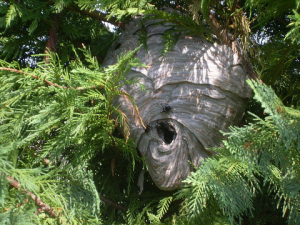Do you know just 20 true species of hornets actually exist? One real specie of a genuine hornet in the U.S. is the European hornet. As its label implies, the European hornet is certainly an added species which came to the U.S. from Europe and adapted to many parts of the U.S.. The European hornet is yellow and brown in color and measures around one and a half inches in length.

Never approach a hornet’s nest; call (714) 503-0380 for help with hornet removal!
Although not a genuine hornet, the baldfaced hornet (Dolichovespula maculata) is listed in this case since most people generally refer to it as a hornet. The baldfaced hornet is roughly one inch long and it’s colored black and white. Both hornets discussed just now have behavior similar to that of a yellow jacket. Size is the most effortlessly recognized distinction since yellow jackets are smaller than hornets.
Hornet Exterminator
In case you come across an aerial nest that is rounded and as large as a basketball (often detected in trees) you may have uncovered a baldfaced hornet nest. European hornets usually make their nests in concealed, above-ground places for example empty trees, crawl spaces, porches and within wall voids. Hornet nests are made of paper-like material designed by the hornets mixing their spit with wood they collect. It’s not at all unusual to observe hornets collecting wood material from an unpainted building, wood fences, or even an aged log.
Although hornets are better known for their power to inflict an excruciating sting, they happen to be handy predators that assist to handle many different bugs that may otherwise become unwanted pests. Nevertheless, hornets really are sociable insects, therefore they will assertively look after their nest from intruders. Although not as intense as yellow jackets, the baldfaced hornet rapidly and assertively protects their colony when sensing any possible danger.
We suggest seeking advice from a specialist before taking any action to control a hornet nest.

